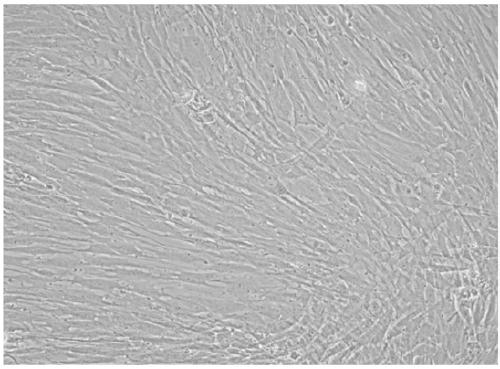Primary isolation method for hair follicle stem cells
A hair follicle stem cell and separation method technology, applied in the field of primary separation of human hair follicle stem cells, can solve the problems of large tissue damage, slow cell growth, and difficulty in adhering to the wall, and achieve stable culture and good cell viability.
- Summary
- Abstract
- Description
- Claims
- Application Information
AI Technical Summary
Problems solved by technology
Method used
Image
Examples
Embodiment 1
[0028] Embodiment 1, primary separation of hair follicle stem cells
[0029] 1. Take the full-thickness scalp (30mm×5mm), rinse it several times with normal saline containing 1× double-antibody, then rinse once with 75% alcohol, and finally store it in glucose solution containing double-antibody and bring it back to the laboratory Operate within 24 hours.
[0030] 2. Cut off the hair outside the scalp and the fat and connective tissue in the subcutaneous tissue, then cut into 3-5mm wide leather strips, wash with sodium chloride injection, then wash in 75% ethanol, and finally use chlorine Sodium chloride injection was washed again.
[0031] 3. Cut the strips into tissue pieces and place them in 0.5 U / ml dispase for overnight digestion at 4°C.
[0032] 4. After 12 hours, take out the tissue block and wash it with sodium chloride injection.
[0033] 5. Take a T25 culture flask, add 1ml of 100μg / ml L-polylysine to cover the bottom of the entire culture flask, put it into a 37°...
Embodiment 2
[0036] Embodiment 2, primary separation of hair follicle stem cells
[0037] 1. Take the full-thickness scalp (30mm×5mm), rinse it several times with normal saline containing 1× double-antibody, then rinse once with 75% alcohol, and finally store it in glucose solution containing double-antibody and bring it back to the laboratory Operate within 24 hours.
[0038] 2. Cut off the hair outside the scalp and the fat and connective tissue in the subcutaneous tissue, then cut into 3-5mm wide leather strips, wash with sodium chloride injection, then wash in 75% ethanol, and finally use chlorine Sodium chloride injection was washed again.
[0039] 3. Cut the strips into tissue pieces and place them in 0.2 U / ml dispase for overnight digestion at 4°C.
[0040] 4. After 12 hours, take out the tissue block and wash it with sodium chloride injection.
[0041] 5. Take a T25 culture flask, add 1ml of 50μg / ml L-polylysine to cover the bottom of the entire culture flask, put it in a 4°C ca...
Embodiment 3
[0044] Embodiment 3, primary separation of hair follicle stem cells
[0045] 1. Take the full-thickness scalp (30mm×5mm), rinse it several times with normal saline containing 1× double-antibody, then rinse once with 75% alcohol, and finally store it in glucose solution containing double-antibody and bring it back to the laboratory Operate within 24 hours.
[0046] 2. Cut off the hair outside the scalp and the fat and connective tissue in the subcutaneous tissue, then cut into 3-5mm wide leather strips, wash with sodium chloride injection, then wash in 75% ethanol, and finally use chlorine Sodium chloride injection was washed again.
[0047] 3. Cut the strips into tissue pieces and place them in 0.3 U / ml dispase for overnight digestion at 4°C.
[0048] 4. After 12 hours, take out the tissue block and wash it with sodium chloride injection.
[0049] 5. Take a T25 culture flask, add 1ml of 70μg / ml L-polylysine to cover the bottom of the entire culture flask, put it into a 37°C...
PUM
| Property | Measurement | Unit |
|---|---|---|
| concentration | aaaaa | aaaaa |
| concentration | aaaaa | aaaaa |
Abstract
Description
Claims
Application Information
 Login to View More
Login to View More - R&D
- Intellectual Property
- Life Sciences
- Materials
- Tech Scout
- Unparalleled Data Quality
- Higher Quality Content
- 60% Fewer Hallucinations
Browse by: Latest US Patents, China's latest patents, Technical Efficacy Thesaurus, Application Domain, Technology Topic, Popular Technical Reports.
© 2025 PatSnap. All rights reserved.Legal|Privacy policy|Modern Slavery Act Transparency Statement|Sitemap|About US| Contact US: help@patsnap.com



